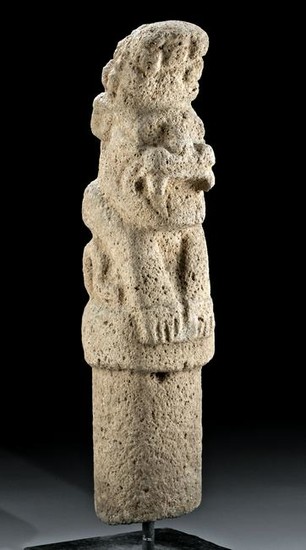Important Maya Stone Post - Jaguar & Maize, ex Museum
Pre-Columbian, southern Mexico, Chiapas region, Izapa Ruins, Maya culture, late Preclassic period, ca. 100 BCE to 100 CE. An incredibly rare fragmentary example of a hand-carved volcanic stone border post that perhaps would have guarded the entrances to villages or agricultural fields. Seated atop a thick, columnar body is a highly stylized jaguar that presents with retracted hind legs, extended forelegs with touching front paws, and a sinuous tail draped down the verso. The raised feline countenance exhibits a gaping, fang-filled mouth, a slender snout with furrowed jowls, recessed circular eyes within puffy sockets, and a pair of spiraling ears. Protruding from the head is a bulbous ear of maize with a conical form and enlarged kernels. A wonderful figural effigy replete with expert construction and multi-layered symbolism. Size: 4.7" W x 20.625" H (11.9 cm x 52.4 cm); 24.4" H (62 cm) on included custom stand.
The importance of this post stems not from the jaguar effigy below but the ear of maize above. Maize was the single most important food crop in ancient Mesoamerica especially among the Maya, and its rich iconography associates it with renewing the agricultural cycle, fertility in both humans and animals, and as a component of humanity itself. According to the Popol Vuh (the Maya story of creation), maize was used by the Maya Maize god (known as Hu Hunahpu) and his sons - along with cacao - to form the first human beings. The dramatic narrative of the Popol Vuh also explains how the Hero Twins Hunahpu and Xbalanque - who possessed a zoomorphic phenotype with a powerful jaguar skin - defeated the monster Vucub Caquix (literally "Seven Macaw") in battle. After Vucub Caquix limped its way to a pair of healers - who had previously aided the Hero Twins prior to their battle with the beast - it was finally and permanently killed by having its eyes and teeth replaced with magical maize kernels.
Provenance: ex-private Tampa, Florida, USA collection; ex-Mint Museum, Charlotte, North Carolina, USA, acquired prior to 1987; ex-private old New England, USA collection, acquired in the 1970s
All items legal to buy/sell under U.S. Statute covering cultural patrimony Code 2600, CHAPTER 14, and are guaranteed to be as described or your money back.
A Certificate of Authenticity will accompany all winning bids.
We ship worldwide to most countries and handle all shipping in-house for your convenience.
#153306
Condition Report: Repair to ear of maize atop jaguar head, with small chips and very light adhesive residue along break lines. Ancient losses to bottom of post body as shown. Nicks and abrasions to post body, jaguar, and maize, with light encrustations, chip to one jaguar fang, and softening to some finer details. Nice earthen deposits throughout. Old inventory number written in ink on bottom of pole body.
View it on
Estimate
Time, Location
Auction House
Pre-Columbian, southern Mexico, Chiapas region, Izapa Ruins, Maya culture, late Preclassic period, ca. 100 BCE to 100 CE. An incredibly rare fragmentary example of a hand-carved volcanic stone border post that perhaps would have guarded the entrances to villages or agricultural fields. Seated atop a thick, columnar body is a highly stylized jaguar that presents with retracted hind legs, extended forelegs with touching front paws, and a sinuous tail draped down the verso. The raised feline countenance exhibits a gaping, fang-filled mouth, a slender snout with furrowed jowls, recessed circular eyes within puffy sockets, and a pair of spiraling ears. Protruding from the head is a bulbous ear of maize with a conical form and enlarged kernels. A wonderful figural effigy replete with expert construction and multi-layered symbolism. Size: 4.7" W x 20.625" H (11.9 cm x 52.4 cm); 24.4" H (62 cm) on included custom stand.
The importance of this post stems not from the jaguar effigy below but the ear of maize above. Maize was the single most important food crop in ancient Mesoamerica especially among the Maya, and its rich iconography associates it with renewing the agricultural cycle, fertility in both humans and animals, and as a component of humanity itself. According to the Popol Vuh (the Maya story of creation), maize was used by the Maya Maize god (known as Hu Hunahpu) and his sons - along with cacao - to form the first human beings. The dramatic narrative of the Popol Vuh also explains how the Hero Twins Hunahpu and Xbalanque - who possessed a zoomorphic phenotype with a powerful jaguar skin - defeated the monster Vucub Caquix (literally "Seven Macaw") in battle. After Vucub Caquix limped its way to a pair of healers - who had previously aided the Hero Twins prior to their battle with the beast - it was finally and permanently killed by having its eyes and teeth replaced with magical maize kernels.
Provenance: ex-private Tampa, Florida, USA collection; ex-Mint Museum, Charlotte, North Carolina, USA, acquired prior to 1987; ex-private old New England, USA collection, acquired in the 1970s
All items legal to buy/sell under U.S. Statute covering cultural patrimony Code 2600, CHAPTER 14, and are guaranteed to be as described or your money back.
A Certificate of Authenticity will accompany all winning bids.
We ship worldwide to most countries and handle all shipping in-house for your convenience.
#153306
Condition Report: Repair to ear of maize atop jaguar head, with small chips and very light adhesive residue along break lines. Ancient losses to bottom of post body as shown. Nicks and abrasions to post body, jaguar, and maize, with light encrustations, chip to one jaguar fang, and softening to some finer details. Nice earthen deposits throughout. Old inventory number written in ink on bottom of pole body.



